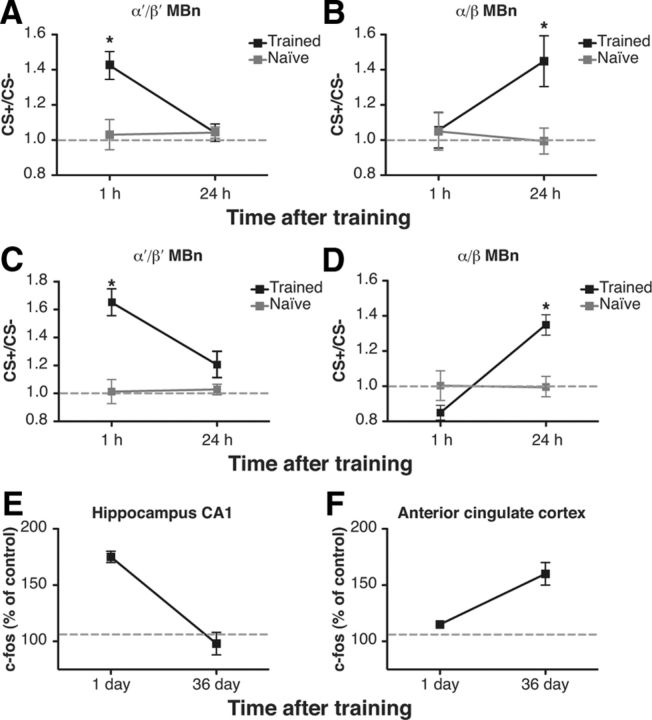Figure 4.
Retrieval of short- and long-term appetitive and aversive memories induces an increased retrieval signal to the learned odor in different MBN subsets. A, Response ratio of the CS+/CS− as a function of time measured in the vertical branch of the α′/β′ MBNs after appetitive olfactory conditioning and in naive flies. A robust increase in calcium influx was detected in the vertical branch during the retrieval of 1 h appetitive memory (Mann–Whitney pairwise comparison, p = 0.0041). This increase was not detected during the retrieval of the appetitive memory 24 h after training (Mann–Whitney pairwise comparison, p = 0.8361). No change was observed at either time point in naive animals. Asterisks indicate a statistically significant difference compared with the naive group. n = 10–16 for each group. B, Response ratio of the CS+/CS− as a function of time measured in the vertical branch of the α/β MBNs after appetitive olfactory conditioning and in naive flies. A robust increase in calcium influx was detected in the vertical branch during the retrieval of 24 h appetitive memory (Mann–Whitney pairwise comparison, p = 0.0183). This increase was not detected during the retrieval of the appetitive memory 1 h after training (Mann–Whitney pairwise comparison, p = 1). No change was observed at either time point in naive animals. Asterisks indicate a statistically significant difference compared with the naive group (n = 10–16 for each group). C, Response ratio of the CS+/CS− as a function of time measured in the vertical branch of the α′/β′ MBNs after aversive olfactory conditioning and in naive flies. A robust increase in calcium influx was detected in the vertical branch during the retrieval of 1 h aversive memory (Mann–Whitney pairwise comparison, p = 0.0011). This increase was not detected during the retrieval of the aversive memory 24 h after training (Mann–Whitney pairwise comparison, p = 0.2618). No change was observed at either time point in naive animals. Asterisks indicate a statistically significant difference compared with the naive group (n = 10–16 for each group). D, Response ratio of the CS+/CS− as a function of time measured in the vertical branch of the α/β MBNs after aversive olfactory conditioning and in naive flies. A robust increase in calcium influx was detected in the vertical branch during the retrieval of 24 h aversive memory (Mann–Whitney pairwise comparison, p = 0.0027). This increase was not detected during the retrieval of the aversive memory 1 h after training (Mann–Whitney pairwise comparison, p = 0.2225). No change was observed at either time point in naive animals. Asterisks indicate a statistically significant difference compared with the naive group (n = 10–16 for each group). E, Expression of the activity-dependent gene c-fos in the hippocampus CA1 region after recent and remote memory tests for contextual fear conditioning in mice. c-fos expression is shown as a percentage relative to controls that were not given foot shock. Figure is adapted with permission from Frankland et al. (2004). F, Expression of the activity-dependent gene c-fos in the anterior cingulate cortex after recent and remote memory tests for contextual fear conditioning in mice. c-fos expression is shown as a percentage relative to controls that were not given footshock. Figure is adapted with permission from Frankland et al. (2004).

